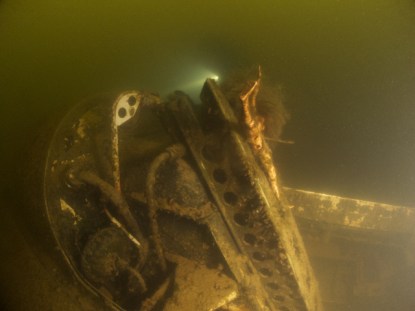1st February 2014
by Richard Booth
The brown tinged water lapping the outer edge of the lake was perhaps the biggest clue as to why we appeared to be the only divers entering the water; that and the biting cold wind and the 5-centigrade water. Still we had travelled over a hundred miles down the A1 so there could be no turning back in our quest to dive some of the iconic aircraft wrecks to be found in the depths of the Blue Lagoon. Indeed standing proudly guard at the side of the lake is an old naval hunter jet, its paintwork now somewhat faded, as it too waits its time to join the other aircraft wrecks in the depths of the flooded quarry.

We strode on and entered the water. Setting compass bearings we headed on out into the brown water. The underwater visibility however was pretty atrocious and it was difficult to keep in touch with each other.
Soon we came across the old 155 mm artillery gun.

After a quick explore around this military relic we moved on, although it strangely proved almost impossible to navigate along a magnetic bearing. Surfacing, it was soon apparent that we were directly under the overhead power lines that cross over the lake, which perhaps helped explain the source of our compass problems?
We swam on across the surface of the lake to an isolated buoy. Was there an aircraft wreck at the bottom of this line? Descending down the line we struck ‘hunter gold’.

In the dim and gloomy conditions we could make out the unmistakeable sleek lines of a jet fighter aircraft resting on the muddy bottom. Carefully exploring around this old relic of the cold war, we took care to float above the wreck trying to avoid stirring up the silt. The cockpit is now open and in the torchlight we could just make out loose wires and the remains of the silt covered instrument panel.


Moving on around the aircraft we explored the tail section before heading back along the fuserlage.

From here we headed back to the surface and on to the final aircraft wreck of the day, a small light aircraft that was sunk just off the lake pier. Here again the visibility proved to be very limited. In the gloom however the light reflecting off the wings indicated that we had indeed found our aircraft wreck, the cockpit is recognisable but locked shut.

The aircraft cowling is still in place locked shut although the engine has long since been removed along with the propeller.

The tail fin however is still intact with even the rear light still intact.

By now the cold water was starting to take its toll and with numb fingers tips we headed back to the slipway, our plane dive mission now complete.
